Comparison of Spectroscopy-Based Methods and Chemometrics to Confirm Classification of Specialty Coffees
Abstract
1. Introduction
2. Methodology
2.1. Roasting Tests and Sensory Evaluation
2.2. ATR-FTIR and NIR Analysis
2.3. Data Processing and Statistical Analysis
3. Results
3.1. ATR-FTIR and NIR Analysis
3.2. Partial Least Squares Regression (PLS)
4. Conclusions
Supplementary Materials
Author Contributions
Funding
Institutional Review Board Statement
Informed Consent Statement
Data Availability Statement
Acknowledgments
Conflicts of Interest
References
- Cecafé. Available online: https://www.cecafe.com.br/en/publications/monthly-exports-report/ (accessed on 14 March 2022).
- Yeretzian, C.; Blank, I.; Wyser, Y. Protecting the Flavors—Freshness as a Key to Quality. In The Craft and Science of Coffee; Folmer, B., Ed.; Elsevier: London, UK, 2017; pp. 329–353. [Google Scholar] [CrossRef]
- Belchior, V.; Botelho, B.G.; Casal, S.; Oliveira, L.S.; Franca, A.S. FTIR and Chemometrics as Effective Tools in Predicting the Quality of Specialty Coffees. Food Anal. Methods 2020, 13, 275–283. [Google Scholar] [CrossRef]
- Craig, A.P.; Botelho, B.G.; Oliveira, L.S.; Franca, A.S. Mid infrared spectroscopy and chemometrics as tools for the classification of roasted coffees by cup quality. Food Chem. 2018, 245, 1052–1061. [Google Scholar] [CrossRef] [PubMed]
- Specialty Coffee Association. Available online: https://sca.coffee/ (accessed on 13 March 2022).
- Pereira, L.L.; Cardoso, W.S.; Guarçoni, R.C.; da Fonseca, A.F.A.; Moreira, T.R.; Caten, C.S. The consistency in the sensory analysis of coffees using Q-graders. Eur. Food Res. Technol. 2017, 243, 1545–1554. [Google Scholar] [CrossRef]
- Belchior, V.; Franca, A.S.; Oliveira, L.S. Potential of diffuse reflectance infrared Fourier transform spectroscopy and chemometrics for coffee quality evaluation. Int. J. Food Eng. 2016, 2, 1–8. [Google Scholar] [CrossRef][Green Version]
- Franca, A.S.; Nollet, L.M.L. Spectroscopic Methods in Food Analysis, 1st ed.; CRC Press: Boca Raton, FL, USA, 2017. [Google Scholar] [CrossRef]
- Munyendo, L.; Njoroge, D.; Hitzmann, B. The Potential of Spectroscopic Techniques in Coffee Analysis—A Review. Processes 2021, 10, 71. [Google Scholar] [CrossRef]
- Wang, N.; Fu, Y.; Lim, L.T. Feasibility Study on Chemometric Discrimination of Roasted Arabica Coffees by Solvent Extractio and Fourier Transform Infrared Spectroscopy. J. Agric. Food Chem. 2011, 59, 3220–3226. [Google Scholar] [CrossRef]
- Reis, N.; Franca, A.S.; Oliveira, L.S. Quantitative evaluation of multiple adulterants in roasted coffee by Diffuse Reflectance Infrared Fourier Transform Spectroscopy (DRIFTS) and chemometrics. Talanta 2013, 115, 563–568. [Google Scholar] [CrossRef]
- Reis, N.; Franca, A.S.; Oliveira, L.S. Concomitant Use of Fourier Transform Infrared Attenuated Total Reflectance Spectroscopy and Chemometrics for Quantification of Multiple Adulterants in Roasted and Ground Coffee. J. Spectrosc. 2016, 2016, 4974173. [Google Scholar] [CrossRef]
- Correia, R.; Cunha, P.; Agnoletti, B.; Pereira, L.; Partelli, F.; Filgueiras, P.; Lacerda, V.; Romão, W. Infravermelho portátil na região do próximo (NIR) aplicado no controle de qualidade de cafés adulterado por borra. Quim. Nova 2022, 45, 392–402. [Google Scholar] [CrossRef]
- Craig, A.P.; Franca, A.S.; Oliveira, L.S. Discrimination between defective and non-defective roasted coffees By Diffuse Reflectance Infrared Fourier Transform Spectroscopy. LWT 2012, 47, 505–511. [Google Scholar] [CrossRef]
- Craig, A.P.; Franca, A.S.; Oliveira, L.S.; Irudayaraj, J.; Ileleji, K. Application of elastic net and infrared spectroscopy in the discrimination between defective and non-defective roasted coffees. Talanta 2014, 128, 393–400. [Google Scholar] [CrossRef]
- Craig, A.P.; Franca, A.S.; Oliveira, L.S.; Irudayaraj, J.; Ileleji, K. Fourier transform infrared spectroscopy and near infrared spectroscopy for the quantification of defects in roasted coffees. Talanta 2015, 134, 379–386. [Google Scholar] [CrossRef] [PubMed]
- Belchior, V.; Botelho, B.G.; Oliveira, L.S.; Franca, A.S. Attenuated Total Reflectance Fourier Transform Spectroscopy (ATR-FTIR) and chemometrics for discrimination of espresso coffees with different sensory characteristics. Food Chem. 2019, 273, 178–185. [Google Scholar] [CrossRef] [PubMed]
- Debona, D.G.; da Silva Oliveira, E.C.; ten Caten, C.S.; Guarçoni, R.C.; Moreira, T.R.; Moreli, A.P.; Pereira, L.L. Sensory analysis and mid-infrared spectroscopy for discriminating roasted specialty coffees. Coffee Sci. 2021, 16, 1–9. [Google Scholar] [CrossRef]
- Hernández-Hierro, J.M.; Cozzolino, D.; Feng, C.H.; Rato, A.E.; Nogales-Bueno, J. Editorial: Recent Advances of Near Infrared Applications in Fruits and Byproducts. Front. Plant Sci. 2022, 13, 858040. [Google Scholar] [CrossRef] [PubMed]
- Abreu, M.B.; Marcheafave, G.G.; Bruns, R.E.; Scarminio, I.S.; Zeraik, M.L. Spectroscopic and Chromatographic Fingerprints for Discrimination of Specialty and Traditional Coffees by Integrated Chemometric Methods. Food Anal. Methods 2020, 13, 2204–2212. [Google Scholar] [CrossRef]
- Illy, A.; Viani, R. Espresso Coffee: The Chemistry of Quality, 2nd ed.; Academic Press: Cambridge, MA, USA, 1998. [Google Scholar]
- Fioresi, D.B.; Pereira, L.L.; da Silva Oliveira, E.C.; Moreira, T.R.; Ramos, A.C. Spectroscopic and Chromatographic Fingerprints for Discrimination of Specialty and Traditional Coffees by Integrated Chemometric Methods. Food Control 2021, 121, 107625. [Google Scholar] [CrossRef]
- Gómez-Ordóñez, E.; Rupérez, P. FTIR-ATR spectroscopy as a tool for polysaccharide identification in edible brown and red seaweeds. Food Hydrocoll. 2011, 25, 1514–1520. [Google Scholar] [CrossRef]
- Franca, A.S.; Mendonça, J.C.F.; Oliveira, S.D. Composition of green and roasted coffees of different cup qualities. LWT 2005, 38, 709–715. [Google Scholar] [CrossRef]
- Manuel, M.N.B.; da Silva, A.C.; Lopes, G.S.; Ribeiro, L.P.D. One-class classification of special agroforestry Brazilian coffee using NIR spectrometry and chemometric tools. Food Chem. 2022, 366, 130480. [Google Scholar] [CrossRef]
- Ribeiro, J.S.; Ferreira, M.M.C.; Salva, T.J.G. Chemometric models for the quantitative descriptive sensory analysis of Arabica coffee beverages using near infrared spectroscopy. Talanta 2022, 83, 1352–1358. [Google Scholar] [CrossRef] [PubMed]
- Tolessa, K.; Rademaker, M.; Baets, B.D.; Boeckx, P. Prediction of specialty coffee cup quality based on near infrared spectra of green coffee beans. Talanta 2016, 150, 367–374. [Google Scholar] [CrossRef] [PubMed]
- Schenker, S.T.R. Espresso coffee: The chemistry of quality. In The Craft and Science of Coffee; Folmer, B., Ed.; Academic Press: Cambridge, MA, USA, 2017; pp. 245–271. [Google Scholar]
- Wei, F.; Tanokura, M. Chemical Changes in the Components of Coffee Beans during Roasting. In Coffee in Health and Disease Prevention; Preedy, V.R., Ed.; Elsevier: London, UK, 2015; pp. 83–91. [Google Scholar] [CrossRef]
- Schenker, S.; Rothgeb, T. The Roast—Creating the Beans Signature. In The Craft and Science of Coffee; Folmer, B., Ed.; Elsevier: London, UK, 2017; pp. 245–271. [Google Scholar]
- Munchow, M.; Alstrup, J.; Steen, I.; Giacalone, D. Roasting Conditions and Coffee Flavor: A Multi-Study Empirical Investigation. Beverages 2020, 6, 29. [Google Scholar] [CrossRef]
- Febvay, L.; Hamon, E.; Recht, R.; Andres, N.; Vincent, M.; Aoudé-Werner, D.; This, H. Identification of markers of thermal processing “roasting” in aqueous extracts of Coffea arabica L. seeds through NMR fingerprinting and chemometrics. Magn. Reson. Chem. 2019, 57, 589–602. [Google Scholar] [CrossRef]
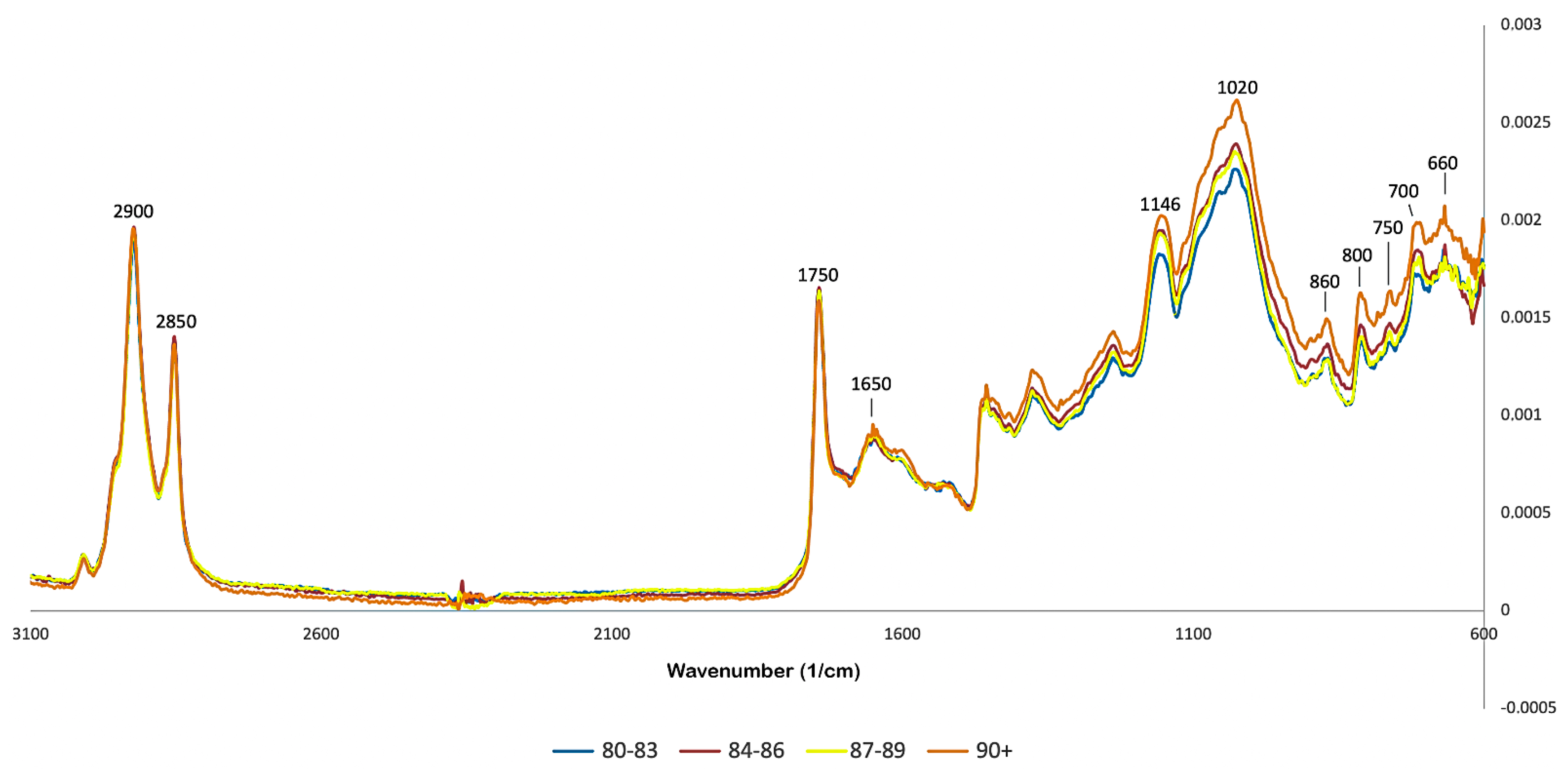
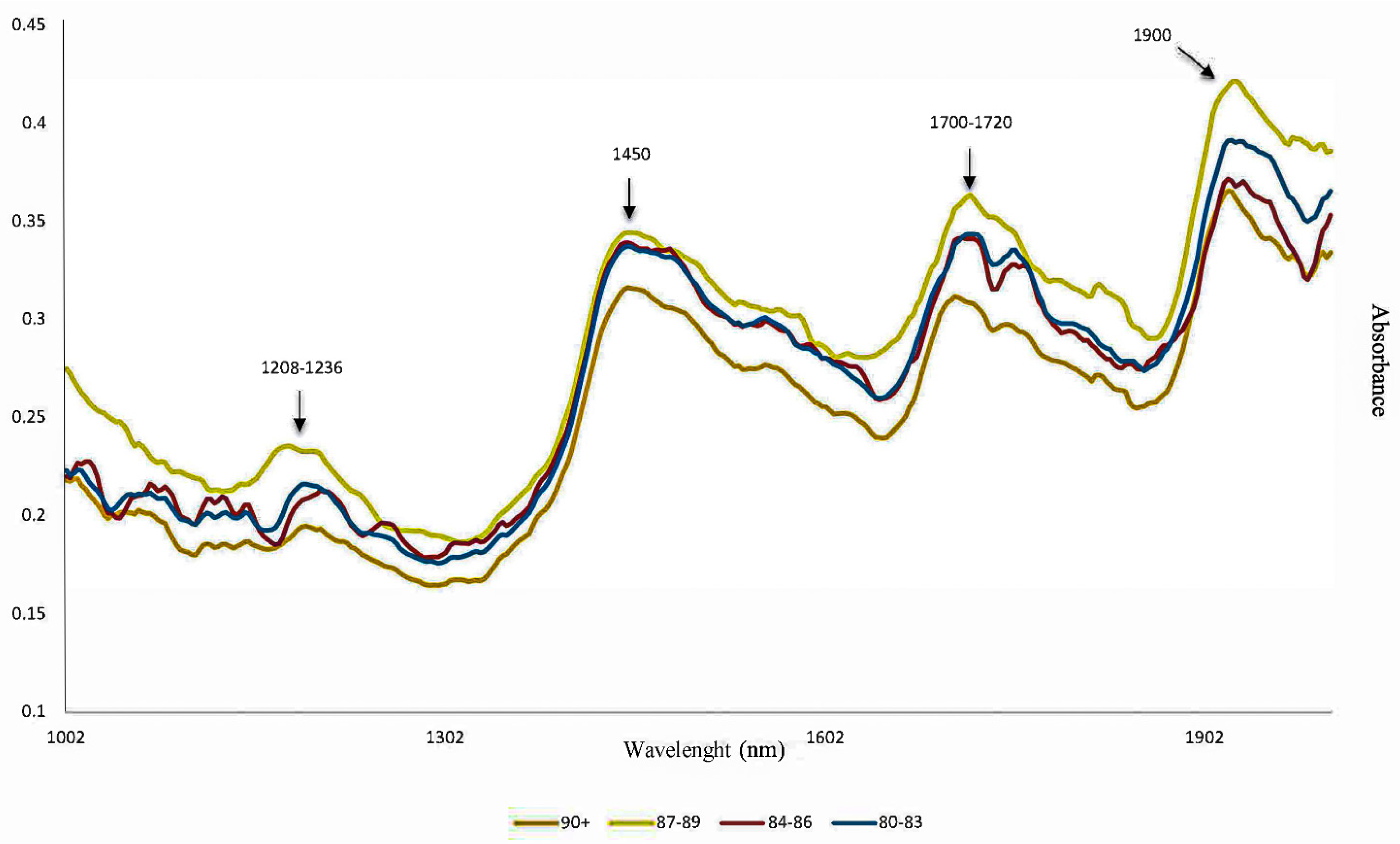
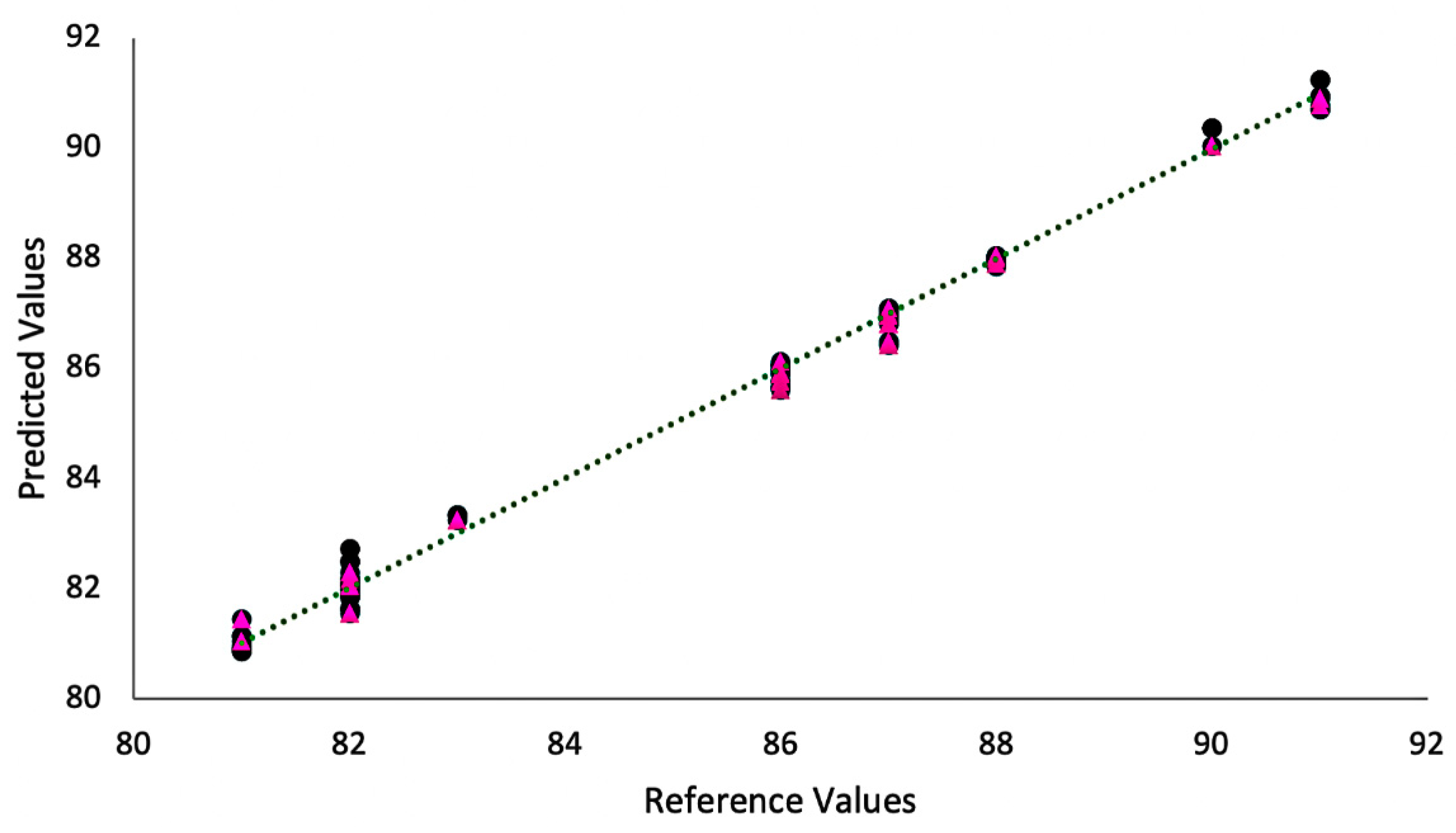
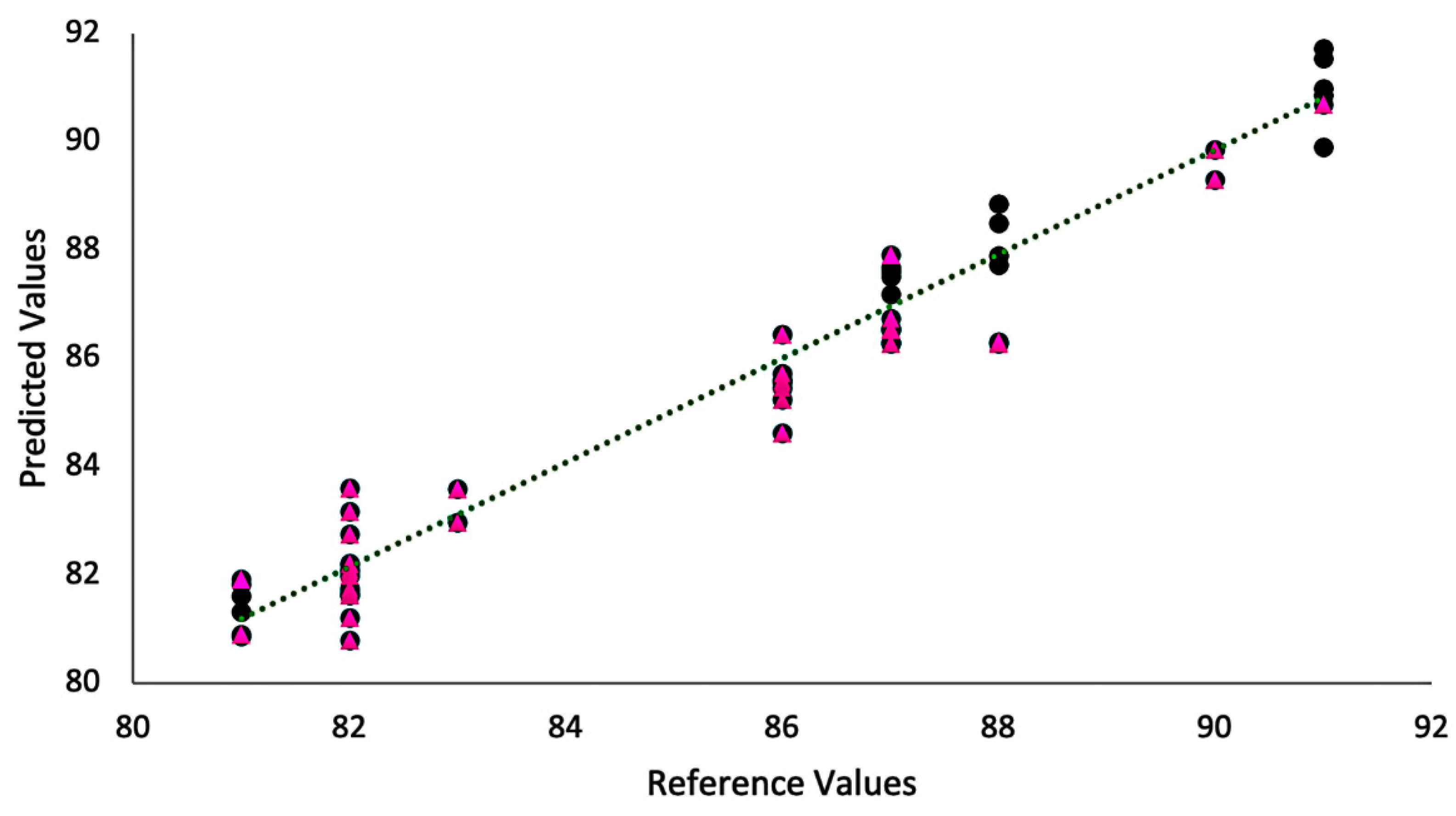
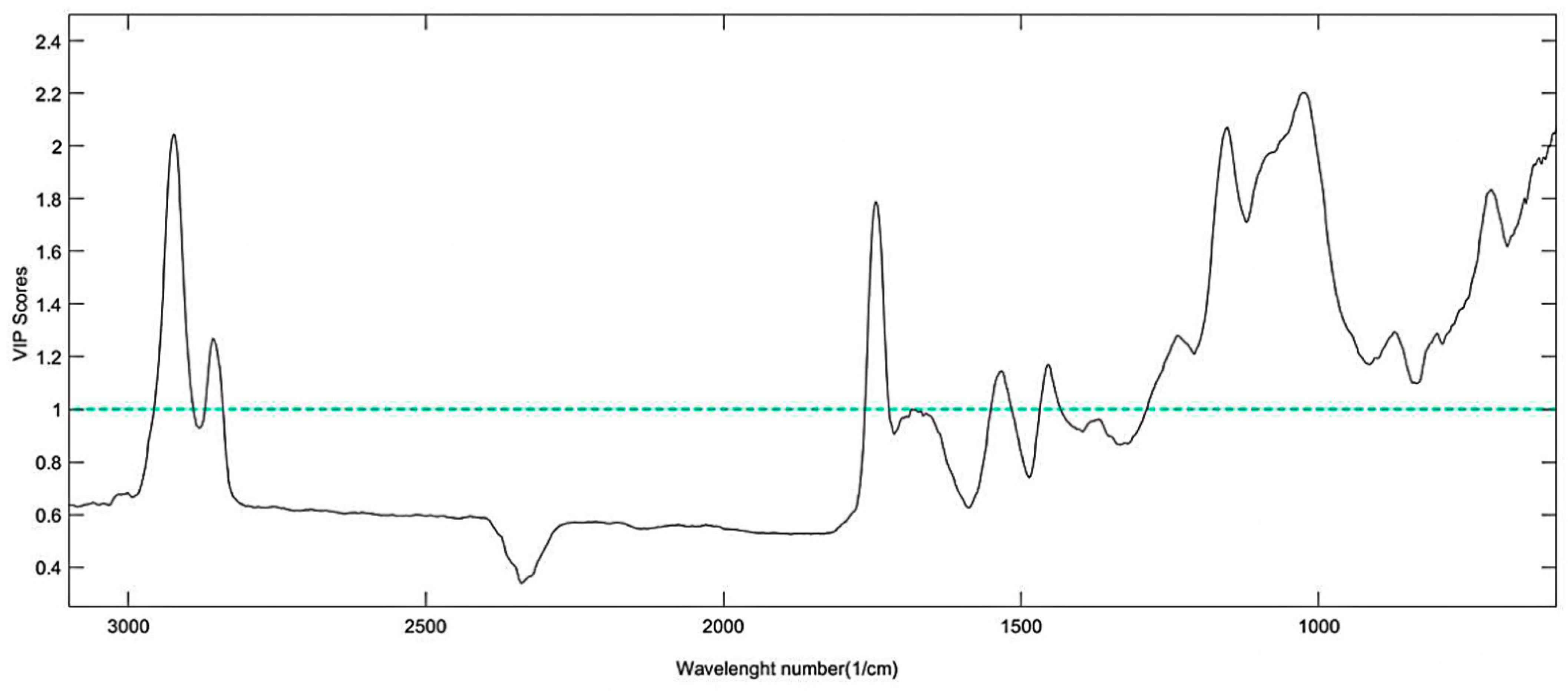
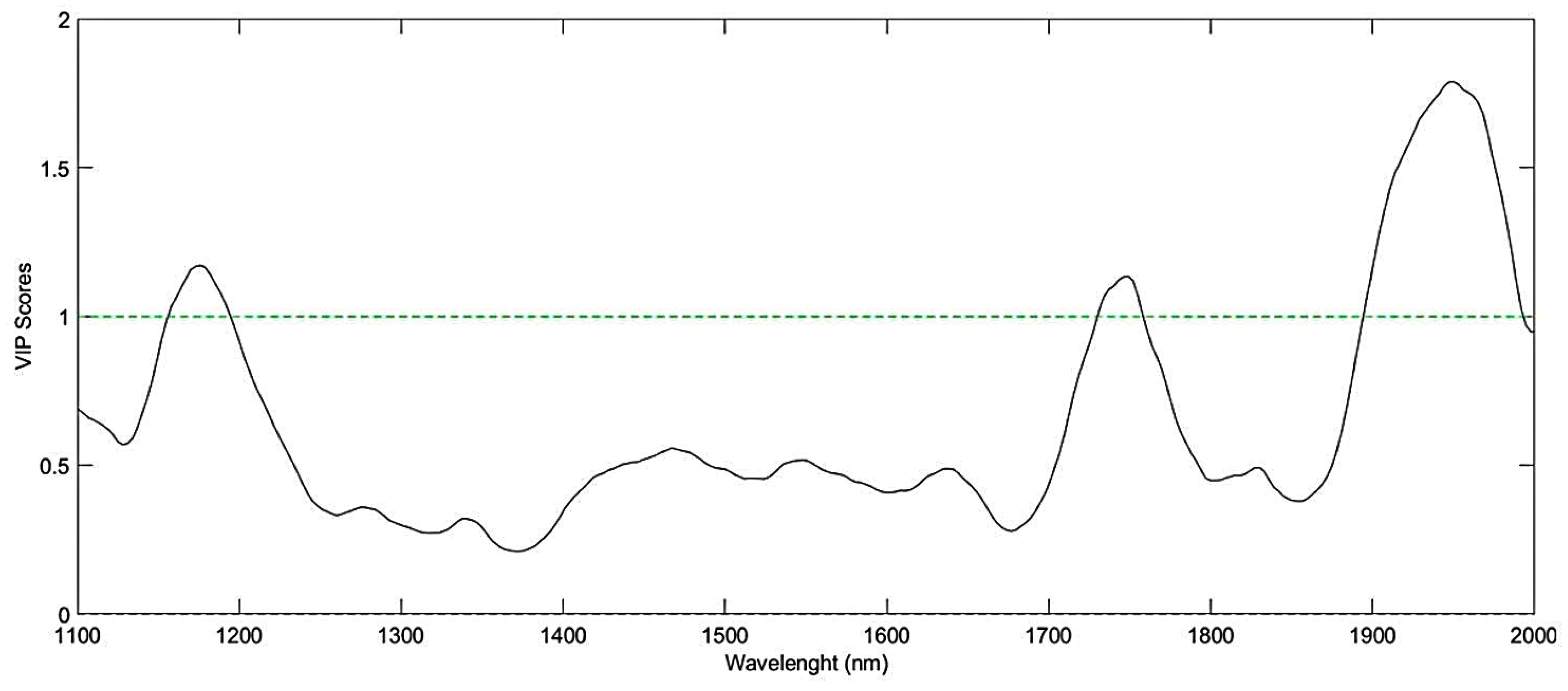
| Model | FTIR | NIRS |
|---|---|---|
| Calibration set | 149 | 74 |
| Validation set | 67 | 37 |
| Latent variables | 2 | 3 |
| RMSEC | 0.23 | 0.50 |
| RMSEP | 0.23 | 0.52 |
| Rc | 0.99 | 0.98 |
| Rv | 0.97 | 0.98 |
Publisher’s Note: MDPI stays neutral with regard to jurisdictional claims in published maps and institutional affiliations. |
© 2022 by the authors. Licensee MDPI, Basel, Switzerland. This article is an open access article distributed under the terms and conditions of the Creative Commons Attribution (CC BY) license (https://creativecommons.org/licenses/by/4.0/).
Share and Cite
Belchior, V.; Botelho, B.G.; Franca, A.S. Comparison of Spectroscopy-Based Methods and Chemometrics to Confirm Classification of Specialty Coffees. Foods 2022, 11, 1655. https://doi.org/10.3390/foods11111655
Belchior V, Botelho BG, Franca AS. Comparison of Spectroscopy-Based Methods and Chemometrics to Confirm Classification of Specialty Coffees. Foods. 2022; 11(11):1655. https://doi.org/10.3390/foods11111655
Chicago/Turabian StyleBelchior, Verônica, Bruno G. Botelho, and Adriana S. Franca. 2022. "Comparison of Spectroscopy-Based Methods and Chemometrics to Confirm Classification of Specialty Coffees" Foods 11, no. 11: 1655. https://doi.org/10.3390/foods11111655
APA StyleBelchior, V., Botelho, B. G., & Franca, A. S. (2022). Comparison of Spectroscopy-Based Methods and Chemometrics to Confirm Classification of Specialty Coffees. Foods, 11(11), 1655. https://doi.org/10.3390/foods11111655






